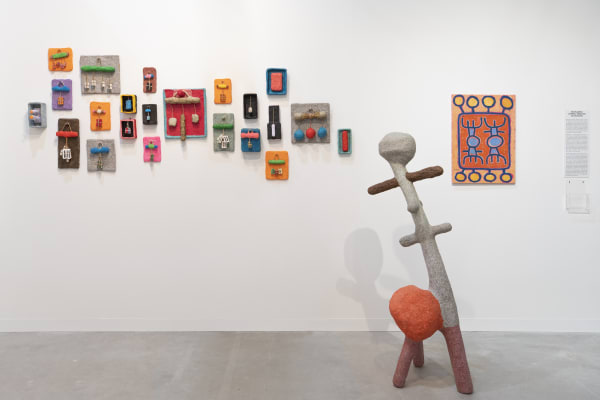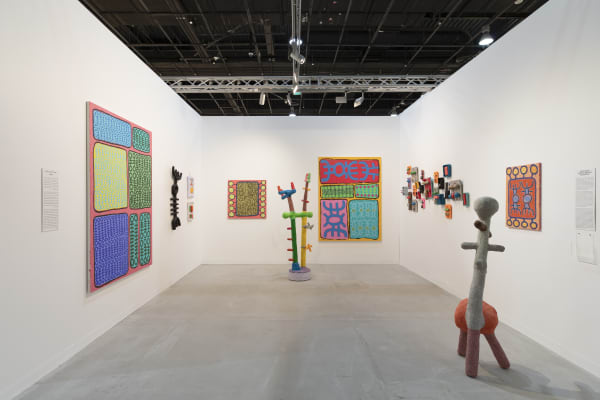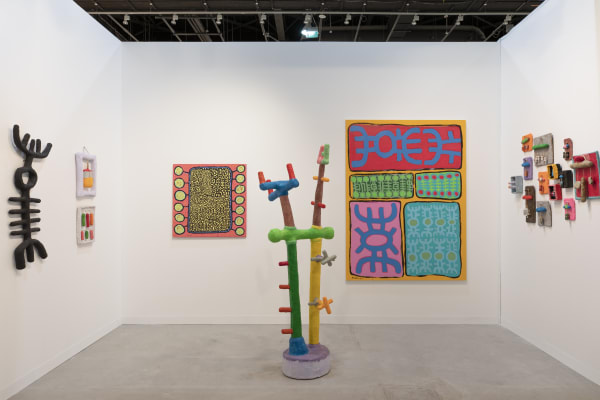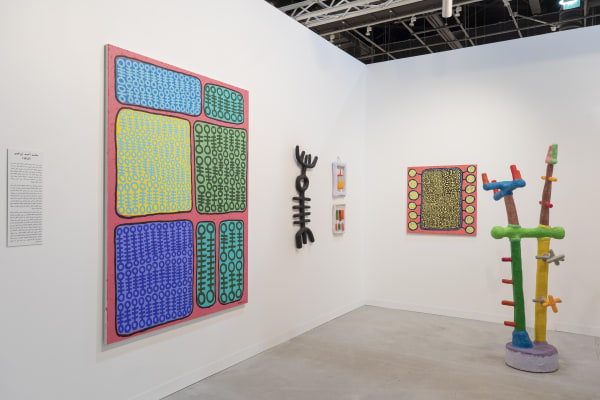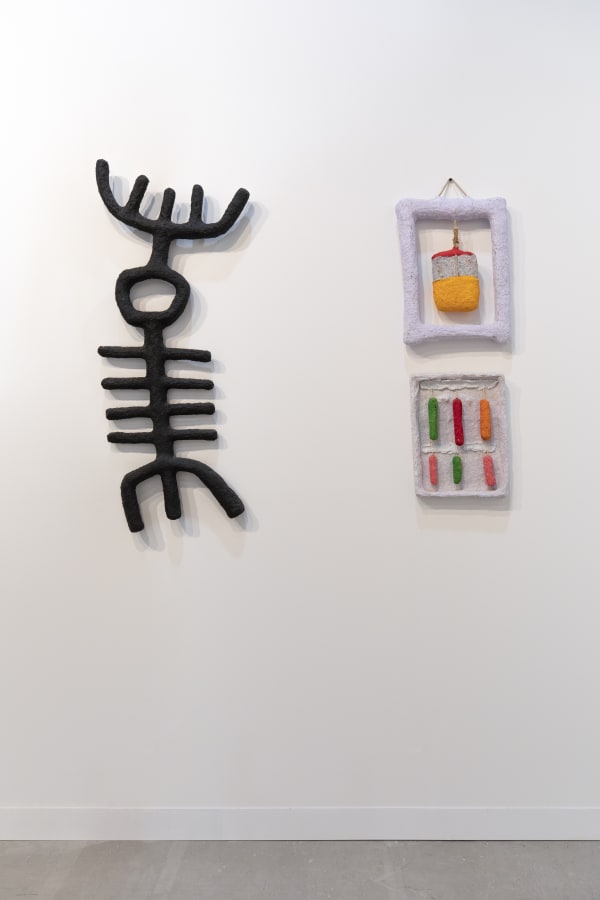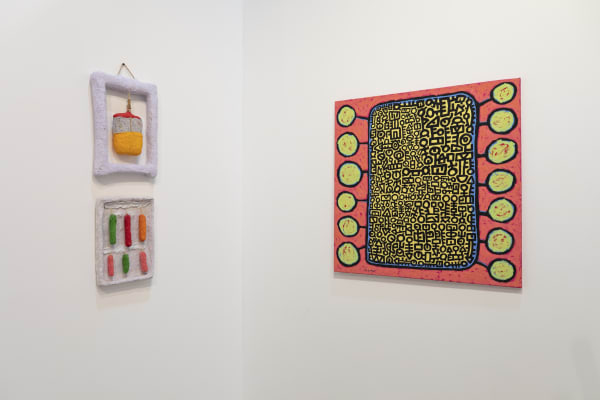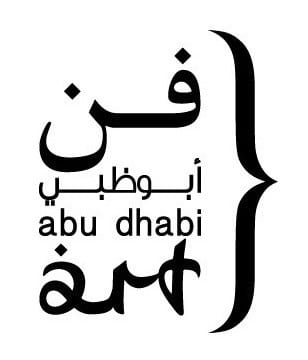 Booth A32 | Special Projects
2–9pm
https://www.abudhabiart.ae/
Booth A32 | Special Projects
2–9pm
https://www.abudhabiart.ae/
Lawrie Shabibi is pleased to return to the 15th edition of Abu Dhabi Art with a solo presentation of works by Emirati artist Mohamed Ahmed Ibrahim. Ibrahim has been selected as this year's visual campaign artist for Abu Dhabi Art and is among the commissioned artists for 'Artist Commissions in Cultural Sites'.
In his practice Ibrahim selects colours and patterns that harmonise with the work he is creating, infusing each piece with a childlike sense of wonder and a view of the world that brims with exuberance. Yet, within this playfulness, a deeper sense of contemplation and reflection emerges. Each artwork serves as a canvas for his interests in archaeology, psychology, and the reinterpretation of familiar objects. By doing so, the artist reinvents the way we perceive and engage with our surroundings. As viewers move through the booth, they are invited to playfully engage with the anamorphic shapes, interpret the work in their own unique ways, and revel in the colours that saturate each corner of the space.
Elevation is a multi-faceted exploration of how art can inspire playfulness, contemplation, and a renewed connection to the world around us. Mohamed Ahmed Ibrahim consistently explores his profound bond with the natural landscape of Khor Fakkan’s mountainous terrain in his studio creations. This connection is discernible in his sculptural installations, paintings, works on paper, and the materials he has employed for over thirty years. His hand-made objects are shaped like primitive tools, bones or parts of trees and appear to have been unearthed from some ancient den, rather than handcrafted. The title used to regroup the artwork selection, hints at both the geographic distance to the sea level and the artist’s spiritual approach to his practice. This challenges preconceptions, and invites visitors to contemplate their place in the world. Through his paintings the artist often reveals his own form of language —inscriptions, lines and abstract forms that are reminiscent of ancient cave drawings— marking time and memory through meditative repetition. Here, viewers witness the harmonious convergence of Ibrahim’s two-dimensional and three-dimensional works. Paintings and sculptures are juxtaposed to illustrate the symbiotic relationship between the two forms. The selection explores how his symbolic motifs resonate across both mediums, bridging the gap between dimensions.
Ibrahim’s practice spans almost 40 years of prolific experimentation and production. He is known as a core member of a tightly knit group of experimental, conceptual artists who have led the vanguard of visual art in the UAE since the 1980s —the group is often referred to as “the five”. This community is widely influential in the Gulf arts scene, but under-studied elsewhere until it began appearing in canonising surveys of the region. Members have included the late Hassan Sharif, Abdullah Al Saadi, Mohammed Kazem, and Hussain Sharif, among others.
Artist Commissions in Cultural Sites
Mohamed Ahmed Ibrahim was commissioned by Abu Dhabi Art to create Al Ain Oasis, an installation to be exhibited in the Cultural Sites of Al Ain. The installation comprises dynamic, colourful tree-like sculptures made of natural and found materials that celebrate the vibrant greenery of Al Ain’s oasis terrains. The artist combines his signature medium of paper-mâché, recycled cardboard and found objects to create a unique landscape of organic forms.
Ibrahim’s practice is deeply rooted in a processed-based approach, which he views as both experiential and meditative. Through this site-specific installation, he creates a profound sense of presence, inviting viewers to experience an encounter with his artistic expression and the UNESCO heritage site of Al Ain oasis. In a departure from his previous works, Ibrahim introduces new elements, adding his symbol motifs directly onto his biomorphic sculptures, a harmonious integration between his two-dimensional paintings and his three-dimensional sculptures.
The commissioned installation reflects his deep connection to the local environment, and in keeping with his practice, addresses concerns of urbanisation’s impact on nature. Conceptualised as a gift to Al Ain, the installation is reminiscent of Ibrahim’s distinct land art works which are inspired by a lifelong relationship with the nature of the region. As visitors engage with the installation, they are encouraged to contemplate local developments in sustainable art, their own connection to their natural surroundings, and ways they can contribute to its preservation.
